Annual Report on Addressing Misconduct and Wrongdoing at the Parole Board of Canada - 2023-24
Message from the Chairperson
We are pleased to present the first edition of the Annual Report on Addressing Misconduct and Wrongdoing at the Parole Board of Canada (PBC) and of the actions taken during the reporting period of April 1, 2023, to March 31, 2024.
The insights and data shared here underscore our dedication to upholding the highest standards of openness, integrity, accountability, fostering trust, and ensuring that ineffective and inappropriate behaviours are promptly identified, addressed and corrected using the most effective strategies and mechanisms in place.
Our objective is not only to showcase past challenges but also to demonstrate transparency by ensuring that all employees and Board members understand the mechanisms in place to address and resolve unethical behaviours.
I remain committed to advancing the renewed dialogue on public service values and ethics and fostering a positive, values-driven culture. Accountability will continue to be upheld with fairness and transparency whenever misconduct or wrongdoing is reported and founded.
Joanne Blanchard
Chairperson
Privacy Protection
Maintaining the protection of personal information and upholding confidentiality and trust is of utmost importance for the PBC. In preparing this first annual report, we stayed committed to protecting the privacy and confidentiality of everyone involved – or possibly involved – in founded cases.
As such, personal and sensitive details have been anonymized and aggregated to uphold privacy, thereby ensuring confidentiality is not compromised. The information pertaining to such cases will continue to remain protected in accordance with the Privacy Act. In cases where there is a potential risk of revealing someone's identity, the data has been withheld in part but shared in a manner that supports presenting the case. This approach reflects our dedication to transparency while upholding our ethical responsibility to safeguard the rights and dignity of all employees and Board members.
In cases where wrongdoing is found as a result of a disclosure made under section 12 of the Public Servants Disclosure Protection Act (PSDPA), the PBC is to promptly provide public access to information that describes the wrongdoing, including identifying the person if necessary, and outline any recommendations and corrective actions taken (if any).
About the PBC
The PBC is headed by a Chairperson who reports to Parliament through the Minister of Public Safety. The PBC is an independent administrative tribunal that, as part of the Canadian criminal justice system, makes quality conditional release and record suspension decisions, and clemency recommendations. The PBC contributes to the protection of society by facilitating, as appropriate, the timely reintegration of offenders as law-abiding citizens. The PBC has legislated responsibilities to:
- order, refuse to order and revoke record suspensions under the Criminal Records Act.
- order or refuse to order expungement of a conviction under the Expungement of Historically Unjust Convictions Act (Expungement Act).
- make recommendations for the exercise of clemency through the Royal Prerogative of Mercy.
The PBC is comprised of public servants (thereafter employees) and Governor in Council (GIC) appointees (thereafter Board members). Board members are GIC appointees made by the Governor General of Canada, on the advice of the King’s Privy Council of Canada (i.e., the Cabinet).
All employees must abide by the PBC’s Public Servant Code of Conduct (only accessible internally at the PBC). All Board members must abide by the Board Members’ Code of Professional Conduct. Both employees and Board members must respect the Values and Ethics Code for the Public Sector.
Considering the statutes governing the two distinct categories of persons employed at the PBC, not all recourse mechanisms apply to both employees and Board members. In cases where a recourse mechanism is not applicable to one or the other, the recourse mechanism will address this applicability accordingly.
2023-24 Misconduct and Wrongdoing Overview
Definition of Misconduct and Wrongdoing
Misconduct is referred to as any deliberate action or omission by an employee or a Board member that violates established rules and guidelines, laws, workplace policies or procedures, ethical principles, standards, conflict of interest requirements, failure to follow reasonable managerial instructions, insubordination, or harassment, which may result in unacceptable, improper or ineffective behaviours that breach an applicable Code of Conduct. In certain cases of misconduct, corrective, disciplinary, or administrative actions may be warranted and considered appropriate.
Note: In cases where a serious breach of a code of conduct goes against the public interest, this can be investigated under the PSDPA and treated as a wrongdoing.
Wrongdoing is exclusively used to refer to serious incidents under the PSDPA that affect the public interest. Article 8 of the PSDPA defines wrongdoing as:
- a contravention of any Act of Parliament or of the legislature of a province, or of any regulations made under any such Act, other than a contravention of section 19 of the PSDPA;
- a misuse of public funds or a public asset;
- a gross mismanagement in the public sector;
- an act or omission that creates a substantial and specific danger to the life, health or safety of persons, or to the environment, other than a danger that is inherent in the performance of the duties or functions of an employee or a Board member;
- a serious breach of any codes of conduct established under section 5 or 6 of the PSDPA; and
- knowingly directing or counselling a person to commit a wrongdoing set out in any of the above paragraphs (a) to (e).
When wrongdoing is founded following an investigation into the matter, recommendations are provided to the Chairperson, and as a result, corrective actions can be implemented, as considered appropriate. Furthermore, information on all founded wrongdoing cases is made publicly accessible.
Recourse Mechanisms for Reporting Misconduct or Wrongdoing
As a first step, and if the situation permits it, employees and Board members are encouraged to explore informal resolution strategies to address and resolve workplace concerns. However, when an employee or a Board member experiences more challenging workplace issues where they might feel uncomfortable discussing matters informally, or if they need to raise allegations of questionable behaviour or unethical conduct, they have the option to seek confidential support through the following resources, each designed to address specific issues at stake.
Disclosure of Wrongdoing under the Public Servants Disclosure Protection Act (PSDPA)
The PSDPA gives federal employees and Board members a secure, formal and confidential process for disclosing wrongdoing in the workplace, with the assurance that they are protected from any acts of reprisal. The PSDPA allows for three secure and confidential channels in which an employee or a Board member can choose from for confidentially reporting allegations of wrongdoing:
- their manager or Vice-Chairperson;
- PBC’s designated Senior Officer for Internal Disclosure;
- the Office of the Public Sector Integrity Commissioner, who is an independent federal organization that handles disclosures of wrongdoing within the federal public sector.
Employees and Board members can refer to PBC’s Intranet page (only accessible internally at the PBC) for more information on the PSDPA along with PBC’s Procedures to Receive, Manage and Deal with Disclosures of Wrongdoing.
Human Resources, Labour Relations
The PBC’s Human Resources (HR), Labour Relations (LR) team aims to foster harmonious and effective workplace relationships by offering specialized guidance and support exclusively to public servant managers on labour relation matters, including those involving formal administrative investigations (or fact-findings), when warranted.
The delegated manager, with the support of LR, can look into acts of inappropriate and unprofessional behaviours that would potentially constitute a breach of the Values and Ethics Code for the Public Sector and/or of the PBC’s Public Servant Code of Conduct. The delegated manager, with the support of LR, can also look into financial mismanagement acts. However, the PSDPA also identifies some of these financial mismanagement acts as a wrongdoing, to which non-compliance cases would be treated under the PSDPA.
When allegations are founded, LR will provide advice, guidance and support to managers to determine the appropriate way to address violations through administrative and/or disciplinary processes, if required.
For more information, managers and employees can refer to PBC’s Intranet page for LR-related matters (only accessible internally at the PBC) or consult the Employee’s Corner (only accessible internally at the PBC). Managers can also contact the LR team by e-mail at gen-pbc-clcc-labour.relations-relationsdetravail@csc-scc.gc.ca.
Board Member Complaint Resolution Process, Professional Standards Section of the Board Member Secretariat
The Professional Standards Section (PSS) under the Board Member Secretariat is responsible for providing advice to Board members on professional conduct, including a consistent and equitable interpretation and application of the Board Members' Code of Professional Conduct.
The PSS also coordinates the Board Member's Complaint Resolution Process and assists Board members by directing them to resources and services regarding terms and conditions of employment, ethical questions, guidelines for political activities, bias and conflicts of interest. This process at the PBC exclusively addresses concerns regarding alleged behaviour by any Board member that is inconsistent with the Board Members' Code of Professional Conduct.
A person who wishes to submit a complaint regarding a Board members’ professional conduct, collegiality, security protocols, or inappropriate use of PBC resources and assets can submit a complaint by completing the Board member complaint form or by contacting the Professional Standards section by e-mail at Professional_Standards-Normes_professionnelles@PBC-CLCC.GC.CA for advice and guidance.
For more information, Board members can refer to PBC’s Intranet page (only accessible internally at the PBC).
Workplace Harassment and Violence Prevention
The Canada Labour Code (CLC) defines Harassment and Violence in the Workplace as any action, conduct or comment, including of a sexual nature, that can reasonably be expected to cause offence, humiliation or other physical or psychological injury or illness to an employee or a Board member, including any prescribed action, conduct or comment.
Note: Allegations of misconduct made under the CLC's Workplace Harassment and Violence Prevention process that would qualify as wrongdoing under the PSDPA may also be made through the internal disclosure of wrongdoing mechanism.
The PBC Policy on Workplace Harassment and Violence Prevention (only accessible internally at the PBC) aims to prevent harassment and violence in the workplace by promoting increased awareness through mandatory training, introduce preventive measures to nurture and maintain a workplace free of harassment and violence, informal and early conflict resolution, as appropriate, investigate notice of occurrencesFootnote 1 with the exclusive purpose of preventing future incidents and the implementation of strategies to negate a situation from arising, and explore the use of alternate dispute resolution mechanisms, as appropriate.
This policy applies to all PBC employees (including casuals and students) and Board members independently of their position, level, or status, as well as contractors, and every other person granted access to workplaces controlled by the PBC. Employees and Board members who experience or witness an incident of harassment or violence are responsible for reporting the incident, either in writing, orally, or by submitting a notice of occurrence to the following:
- their manager (includes Vice-Chairpersons, Executives, and Senior Counsel);
- PBC’s Designated Recipient by e-mail at NOOHS.GEN-PBC-CLCC@PBC-CLCC.GC.CA or by telephone at 343-990-4519.
If the incident involves their manager or Vice-Chairperson, they must report it to the PBC’s Designated Recipient.
For more information on Workplace Harassment and Violence Prevention, please refer to the National Occupational Health and Safety Unit’s Intranet page (only accessible internally at the PBC).
Occupational Health and Safety
Occupational Health and Safety (OHS) is governed by the CLC Part II and the Canada Occupational Health and Safety Regulations. Its purpose is to promote a safe and healthy workplace for all employees and Board members working at the PBC, and to identify and prevent accidents and injury to health arising out of, linked with, or occurring in the course of employment.
The PBC is required to protect the health and safety of all employees and Board members in the performance of their work by ensuring that complaints, including refusals to work, and hazardous occurrences are investigated, reported and recorded. As such, the Canada Occupational Health and Safety Regulations require that employees and Board members report to the PBC every accident or hazardous occurrence in the course of their work that has or is likely to cause an injury.
Employees and Board members have a duty to report any situation they believe to be a contravention of the CLC. For more information, employees and Board members can contact the National Occupational Health and Safety Advisor by e-mail at noohs.gen-pbc-clcc@pbc-clcc.gc.ca, or visit National Occupational Health and Safety Unit’s Intranet page (only accessible internally at the PBC).
Departmental Security Management
The Directive on Security Management (DSM) is a directive under the Policy on Government Security (PGS) aimed at ensuring efficient, effective, and accountable security management within federal government departments and agencies.
One such security control that the PBC is responsible for and administers is security screening. It is a fundamental activity that establishes and maintains a foundation of trust within government, between government and Canadians, and between Canada and other countries. Individuals must be officially granted the required security status or security clearance before they are assigned duties or assigned to a position, and/or before they are granted access to sensitive information, assets or facilities. The decision by the PBC’s delegated security officer to grant a security status or clearance confirms that an individual is eligible to access sensitive information, assets or facilities.
The security screening model also includes mechanisms for dealing with adverse information that may be uncovered during the security screening process, or at a later time when new information is uncovered or reported. Mechanisms may involve a security interview to resolve doubt, or may require a review for cause. A review for cause is a reassessment of an individual's eligibility to hold a security status or clearance previously granted. It requires that an investigation and security interview be conducted. When required, security screening may also be redone. Depending on the outcome of the resolution of doubt process or a review for cause, the individual’s security status or clearance may be granted or their continued eligibility is validated for a security status or clearance previously granted. Otherwise, there may be a denial or revocation of the security status or clearance if there is reasonable doubt as to an individual's reliability or loyalty to Canada, or whether the person can be trusted to safeguard sensitive information, assets or facilities.
Another security control under the DSM is physical security, which includes the design of the facility environment, access management, secure storage, transport, transmittal and destruction, etc. When security concerns or misconduct allegations are raised or brought forward, the Board’s security functional specialists may be delegated to perform a fact-finding exercise, conduct an administrative investigation into the matter which can result in disciplinary action, or they may conduct a review for cause under the Directive on Security Screening which can result in an administrative decision to revoke a security status or clearance.
If an employee or a Board member has any questions regarding PBC’s security services or need to report a potential security incident or breach, they can confidentially send an e-mail to SecurityServices-Servicesdesecurite.GEN-PBC-CLCC@pbc-clcc.gc.ca.
Network usage
The Policy on Service and Digital governs the set of rules on how the Government of Canada organizations manage service delivery, information and data, information technology, and cyber security in the digital era.
At the PBC, the Correctional Service of Canada (CSC) supplies PBC employees and Board members with the electronic and network resources, which are governed by CSC’s Commissioner’s Directive on the Use of Electronic Resources.
Inappropriate or unacceptable network activities that violate Treasury Board Secretariat policies (as defined in Appendix D of the Directive on Service and Digital) or any other government policy governing the use of PBC’s systems and network, are investigated in collaboration with the PBC’s Chief Information Officer, and addressed accordingly. Violations can include breaches of information security, failure to protect information or data from unauthorized access, inappropriate or unauthorized access to information, installing unauthorized software or external devices, conducting unlawful activities (as outlined in Appendix B of the Treasury Board Secretariat’s Directive on Service and Digital) as well as any other inappropriate activity that goes against PBC’s Policy on the Use of Web 2.0 (only accessible to PBC employees and Board members via Intranet).
Other Resources and External Recourse Mechanisms for Reporting Misconduct or Wrongdoing
Employees and Board members also have access to external programs and services specifically designed to assist in resolving workplace concerns and issues, such as:
Discrimination
Discrimination is unfair or negative treatment based on factors like race, age, or disability. It can include harassment when workplace actions or decisions create an intimidating, hostile, or threatening work environment based on a personal characteristic, or a status protected under anti-discrimination laws.
The Canadian Human Rights Act (CHRA)protects all individuals from harassment and discrimination based on one or more prohibited grounds, including race, national or ethnic origin, colour, religion, age, sex (includes pregnancy), sexual orientation, gender identity or expression, marital status, family status, disability (includes physical and mental disability), genetic characteristics, a conviction for which a pardon has been granted or a record suspended.
Any employee or Board member who believes they have experienced discrimination are strongly encouraged to either seek guidance from their manager or Vice-Chairperson, LR, their union or contact the Canadian Human Rights Commission to file a human rights complaint.
Accessible Canada Act
The Accessible Canada Act focuses on identifying and removing barriers as well as the prevention of new barriers – especially for persons with disabilities, within the eight areas outlined under article 5 of this Act. At the PBC, we are committed to building a culture of inclusiveness by ensuring that everyone who uses the PBC services is able to do so fairly and equitably, and with dignity, independence and without encountering any barriers.
If an employee or a Board member has suffered harm as a result of PBC’s accessibility plans, feedback processes or progress reports, they may be able to file a complaint with the Accessibility Commissioner through the Canadian Human Rights Commission.
If an employee or a Board member has experienced an accessibility barrier at the PBC, the first step is to contact the PBC’s Designated Official for Accessibility to provide feedback about the barrier.
Staffing Complaints and Investigations
Process for employees
PBC employees who have concerns regarding irregularities in an appointment process, or have information that fraud might have occurred during an appointment process, or of an allegation of improper political activities, can either reach out to the Staffing team by e-mail at staffing-dotation.gen-pbc-clcc@pbc-clcc.gc.ca or submit a request for investigation to the Public Service Commission (PSC).
In cases where the final notification of an internal appointment or proposed appointment has been published, employees can also file a staffing complaint with the Federal Public Sector Labour Relations and Employment Board (FPSLREB) under the Public Service Employment Act (PSEA).
The FPSLREB will accept complaints in cases that involve:
- Abuse of authority in the application of merit;
- Abuse of authority in the choice of process (advertised or non-advertised process);
- Failure to assess the complainant in the language of their choice.
Process for Board members
Board members who have concerns following their participation in a selection process are encouraged to contact the person identified on the Notice of Opportunity.
On-Demand Informal Services for Workplace Well-Being
The PBC provides all employees and Board members with free and direct access to a various range of informal resources aimed at fostering and supporting positive mental health and overall well-being. The following services are informal, confidential, neutral, and completely voluntary.
Informal Conflict Management Services (ICMS)
All employees and Board members can access the Informal Conflict Management Services (only accessible on a Government of Canada network) to prevent the escalation of conflict by managing and resolving conflicts in the workplace informally, confidentially, quickly and constructively. For more information or to contact the ICMS directly, employees and Board members can consult PBC’s Intranet page (only accessible internally at the PBC).
Ombuds Services
The Ombuds Services is a confidential, informal, early resolution mechanism available to all employees and Board members seeking to resolve workplace issues. For more information or to contact the Ombuds Services directly, employees and Board members can consult PBC’s Intranet page (only accessible internally at the PBC).
The Employee Assistance Program (EAP) and LifeSpeak
The Employee Assistance Program (EAP) offers short-term mental health support to employees, Board members and their immediate family members. LifeSpeak, a web-based learning platform with expert-led videos, articles and tools on mental health, wellness and resilience, is also available. Employees, Board members and/or immediate family members can contact the EAP by using one of the mechanisms provided here or consult PBC’s Intranet page ( only accessible internally at the PBC) for more information on the EAP and LifeSpeak.
Addressing and Preventing Misconduct and Wrongdoing at the PBC
All reported allegations regarding misconduct or wrongdoing are taken with the utmost seriousness and addressed promptly and accordingly. Each allegation undergoes a thorough review to determine its eligibility and to identify the most appropriate course of action.
When the information initially disclosed is insufficient to make a determination, an investigative processFootnote 2 is launched and can take the form of a fact-finding exercise or an investigation. A fact-finding exercise is undertaken when a situation is relatively straightforward, the facts are not in dispute by various parties, and the facts do not require an important level of investigation. When the situation is more complex and additional information is required, a formal investigation may be initiated.
The reporting of relevant cases follows the sequence outlined in the Recourse Mechanisms for Reporting Misconduct or Wrongdoing, aligning with the order in which each area for reported misconduct and wrongdoing activities mechanisms were described.
Internal Disclosures of Wrongdoing under the PSDPA
During the 2023-24 fiscal year, notably from April 1, 2023, to March 31, 2024, the PBC did not receive any disclosures of wrongdoing, as follows:
- Zero (0) – general enquiries;
- Zero (0) – a contravention of any act of Parliament or of the legislature of a province or territory;
- Zero (0) – a misuse of public funds or a public asset;
- Zero (0) – gross mismanagement in the public sector;
- Zero (0) – an act or omission that creates a substantial and specific danger to the life, health or safety of persons or the environment;
- Zero (0) – a serious breach of a code of conduct;
- Zero (0) – knowingly directing or counselling a person to commit a wrongdoing.
The above overview of disclosure-related activities can be viewed here: Annual Report on the Public Servants Disclosure Protection Act 2023 to 2024.
Furthermore, the Office of the Public Sector Integrity Commissioner did not publish any reports related to the PBC during the reporting period.
Breach of PBC’s Public Servant Code of Conduct and the Public Sector Values and Ethics Code
The PBC’s Public Servant Code of Conduct includes a very wide range of conduct that employees must adhere to and uphold. A breach occurs when an employee contravenes expected values and ethics behaviours outlined in the Values and Ethics Code for the Public Sector or as enumerated in the PBC’s Code of Conduct.
Examples of a breach include but are not limited to inappropriate or unprofessional conduct, threatening or intimidating a coworker or supervisor, theft of time, tardiness, unauthorized absenteeism or absence from work, unauthorized leave.
During the 2023-24 fiscal year, notably from April 1, 2023, to March 31, 2024:
- A total of eighteen (18) complaints/alleged breaches were received.
- Of the above, six (6) investigative processes were conducted.
- Of the above, five (5) cases were founded, four (4) of which were addressed by administrative measures and one (1) employee resigned before the disciplinary process was concluded.
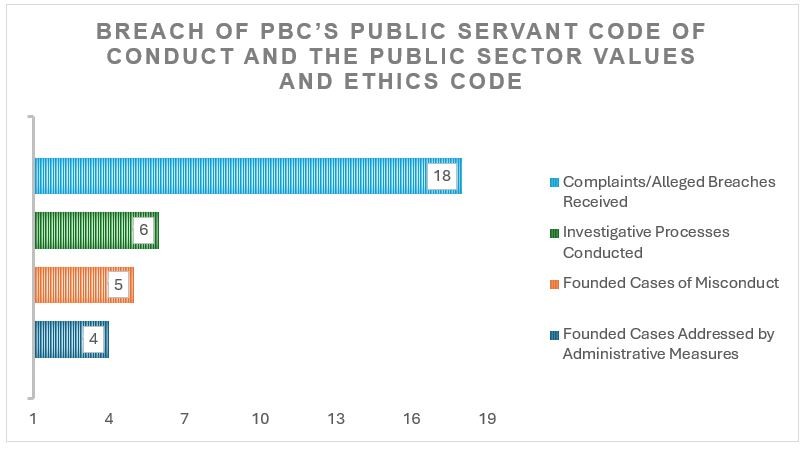
Text equivalent of figure 1. Breach of PBC’s Public Servant Code of Conduct and the Public Sector Values and Ethics Code
| Complaints/Alleged Breaches Received | Investigative Processes Conducted | Founded Cases of Misconduct | Founded Cases Addressed by Administrative Measures |
|---|---|---|---|
| 18 | 6 | 5 | 4 |
Financial Mismanagement
During the 2023-24 fiscal year, notably from April 1, 2023, to March 31, 2024:
- No financial mismanagement cases were received.
Board Member Complaint Resolution Process
During the 2023-24 fiscal year, notably from April 1, 2023, to March 31, 2024:
- A total of nine (9) complaints were received regarding alleged Board member conduct matters.
- Of those, five (5) complaints were deemed admissible, and for which an investigation was carried out.
- Of those, zero (0) resulted in a breach of the Code of Professional Conduct.
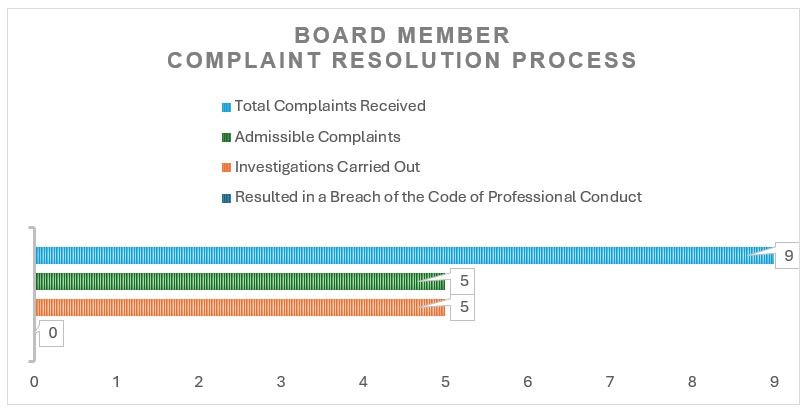
Text equivalent of figure 2. Board Member Complaint Resolution Process
| Total Complaints Received | Admissible Complaints | Investigations Carried Out | Resulted in a Breach of the Code of Professional Conduct |
|---|---|---|---|
| 9 | 5 | 5 | 0 |
Workplace Harassment and Violence Prevention (exclusively under the resolution/prevention process)
During the 2023 calendar yearFootnote 3 , notably from January 1, 2023, to December 31, 2023, the PBC received a total of six (6) notices of occurrences involving Non-Sexual Harassment and Violence. No occurrences of Sexual Harassment and Violence were received.
Of the above, the six (6) occurrences received were resolved by:
- One (1) – Negotiated Resolution
- Zero (0) – Conciliation
- Zero (0) – Investigation
- Zero (0) – Work Place Assessment
- Zero (0) – Principal Party Could Not Be Identified
The remaining five (5) occurrences were addressed through internal and external support resources as it involves Employee / Domestic ViolenceFootnote 4 .
Of the above six (6) occurrences received, the following relationship between the Principal PartyFootnote 5 and the Responding PartyFootnote 6 were:
- Zero (0) – Employee / Employee
- One (1) – Employee / Supervisor, Manager
- Zero (0) – Supervisor, Manager / Employee
- Zero (0) – Employee / Third Party, Client, Contractor, Public
- Five (5) – Employee / Domestic Violence
- Zero (0) – Employee / Other
Of the six (6) occurrences received, the following were related to the Prohibited Grounds for Discrimination under the CHRA:
- Zero (0) – related to Prohibited Grounds of Discrimination
Of the six (6) occurrences received, they occurred in the following location:
- One (1) – Workplaces Controlled by Employer
- Five (5) – Workplaces Not Controlled by Employer
- Zero (0) – Travel Status
- Zero (0) – Other
As referenced earlier, under the Work Place Harassment and Violence Prevention Regulations, which outlines processes for preventing and addressing workplace harassment and violence, the policy aims to identify risks, prevent workplace harassment and violence, and resolve systemic issues affecting employees. Restoring the workplace involves rebuilding a health and safe environment and working relationships after a reported incident of harassment and violence occurrences.
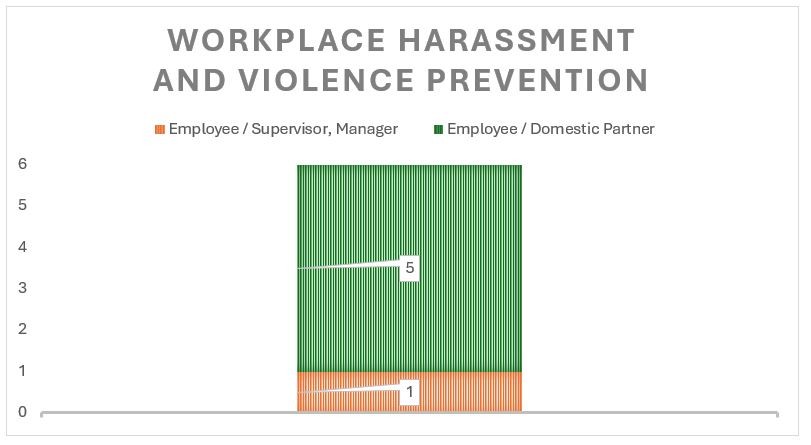
Text equivalent of figure 3. Workplace Harassment and Violence Prevention
| Employee / Domestic Partner | Employee / Supervisor, Manager |
|---|---|
| 5 | 1 |
Harassment and/or Discrimination (initiated through a separate administrative process, independent of the resolution/prevention process)
During the 2023-24 fiscal year, notably from April 1, 2023, to March 31, 2024:
- A total of eleven (11) complaints/alleged breaches were received.
- Of the above, five (5) investigative processes were conducted.
- Of the above, zero (0) cases were founded.
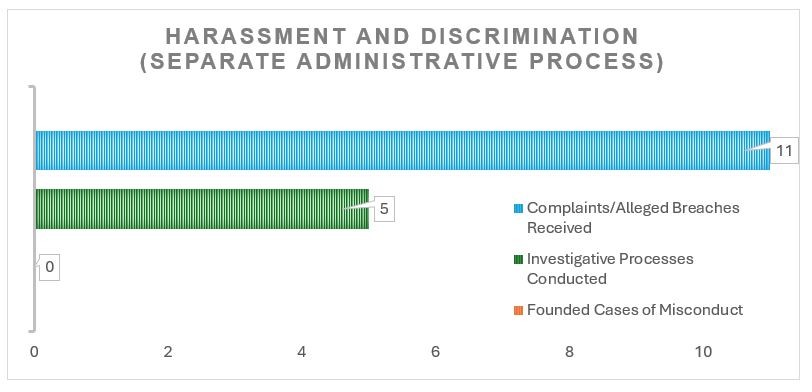
Text equivalent of figure 4. Harassment and Discrimination (separate administrative process)
| Complaints/Alleged Breaches Received | Investigative Processes Conducted | Founded Cases of Misconduct |
|---|---|---|
| 11 | 5 | 0 |
Occupational Health and Safety
During the 2023 calendar yearFootnote 7 , notably from January 1, 2023, to December 31, 2023:
- A total of three (3) complaints were received and resolved under Part II of the CLC.
- Zero (0) refusals to work have been filed alleging dangerous working conditions.
- A total of ten (10) Health and Safety Hazards were identified and nine (9) were resolved (The remaining hazard was resolved in the following calendar year).
- A total of eleven (11) injuries/illnesses were investigated, reported and recorded.
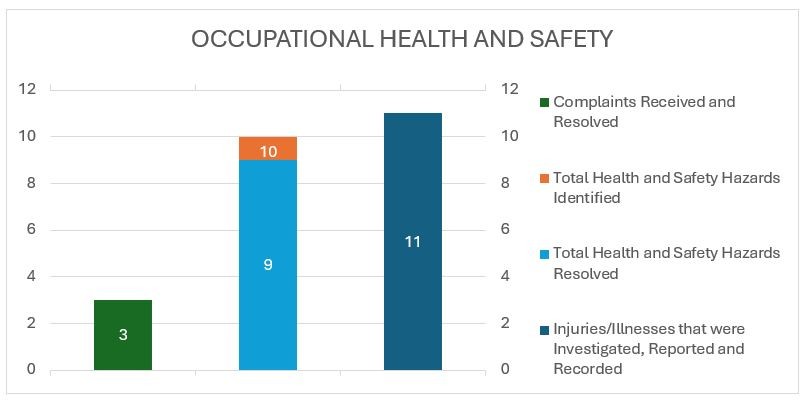
Text equivalent of figure 5. Occupational Health and Safety
| Complaints Received and Resolved | Total Health and Safety Hazards Identified | Total Health and Safety Hazards Resolved | Injuries/Illnesses that were Investigated, Reported and Recorded |
|---|---|---|---|
| 3 | 10 | 9 | 11 |
Departmental Security Violations
During the 2023-24 fiscal year, notably from April 1, 2023, to March 31, 2024:
- No documented instances were received of security complaints, violations or concerns related to misconduct that would have warranted an investigation or a revocation of an employee's or a Board member’s security clearance or status.
Violations of the Network Acceptable Use of Electronic Resources
During the 2023-24 fiscal year, notably from April 1, 2023, to March 31, 2024:
- No reported violations of the Network Acceptable Use of Electronic Resources were received.
Administrative or Disciplinary Measures Taken in Founded Cases of Misconduct and Wrongdoing
In certain situations, and when considered appropriate, administrative or disciplinary measures can be applied to founded cases of misconduct.
An administrative measure refers to a range of corrective actions used to manage, control, address and/or correct inappropriate behaviour. These measures are typically non-disciplinary and aim to ensure compliance, mitigate risks, or uphold the integrity of operations. Measures include but are not limited to suggesting training, coaching, recovery of funds, modifying the employee's system access privileges, revocation of reliability status or security clearance, implementing procedural changes, reiterating expectations, etc.
A disciplinary measure refers to the PBC’s response to founded misconduct or violations of policy instruments. These measures are not only intended to correct behaviours, but rather to enforce accountability, and maintain ethical and professional standards. The goal of disciplinary measures is to discourage employees from engaging in misconduct, and when misconduct occurs, to encourage the employee to rectify their behaviour and comply with the established standard of conduct, unless the situation warrants a termination of employment. Examples of disciplinary measures that may be enforced include verbal or written warnings, suspension, demotion, monetary penalties, or dismissal, depending on the severity of the breach.
During the 2023-24 fiscal year, notably from April 1, 2023, to March 31, 2024:
- A total of four (4) administrative measures were imposed for breaches of PBC’s Public Servant Code of Conduct and/or the Public Sector Values and Ethics Code
- No disciplinary measures were imposed.
In instances of misconduct by a Board member, the Chairperson may implement mitigating actions or resolution strategies to address and correct inappropriate behaviour effectively. As well, as per section 155.1 (1) of the Corrections and Conditional Release Act (CCRA), the Chairperson may recommend to the Minister of Public Safety to determine whether the Board member should be subject to any disciplinary or remedial measures based on the reported misconduct.
In the reporting period, no recommendations to the Minister as per section 155.1 (1) of the CCRA was made.
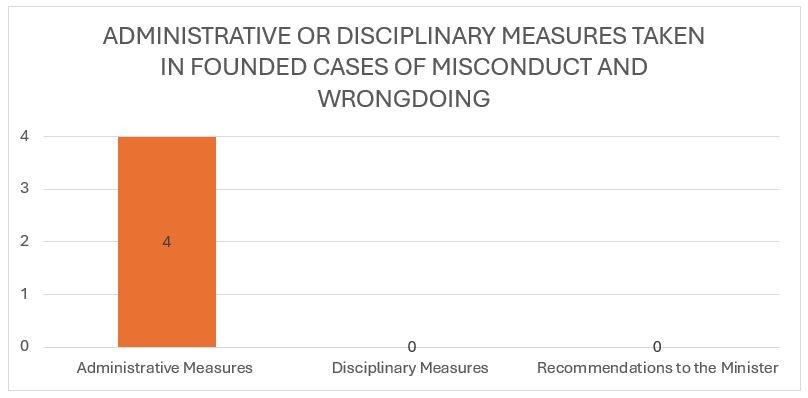
Text equivalent of figure 6. Administrative or Disciplinary Measures Taken in Founded Cases of Misconduct and Wrongdoing
| Administrative Measures | 4 |
|---|---|
| Disciplinary Measures | 0 |
| Recommendations to the Minister | 0 |
Conclusion
The PBC is deeply committed to addressing all matters and concerns brought forward with the utmost respect, seriousness and ensure that integrity, fairness, confidentiality and diligence are applied in every step of the process.
The PBC remains optimistic that the establishment of this first annual report on misconduct and wrongdoing will significantly enhance employees’ and Board members’ awareness, sense of empowerment, motivating and encouraging them to take an active and decisive role in fostering a healthy, respectful, inclusive and supportive workplace, and upholds openness, transparency and accountability in addressing misconduct and wrongdoing acts.
All PBC employees and Board members are expected to adhere to the ethical standards outlined in their respective Codes of Conduct. Reporting misconduct and wrongdoing is a shared responsibility that everyone is expected to uphold.